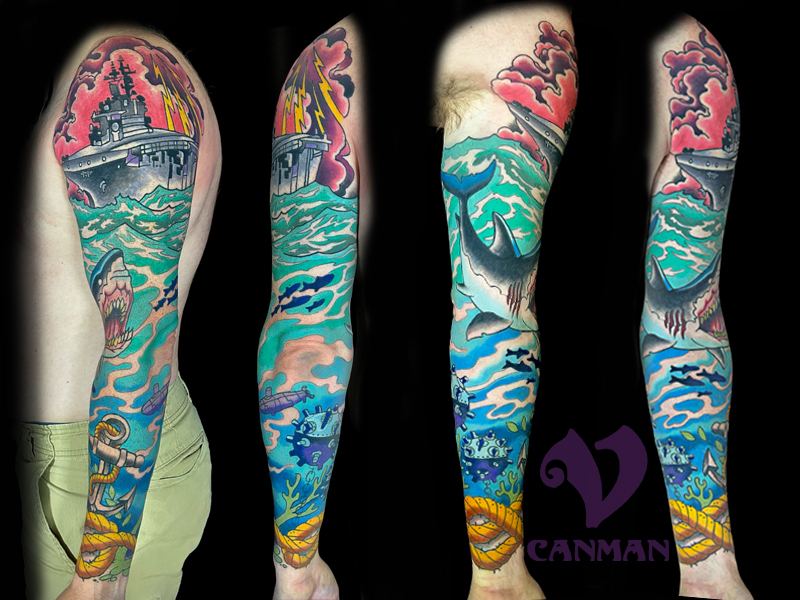This Navy tattoo is a great example of Canman’s bold color and illustrative style.
This project took 6 sessions with an average 2.5 – 3.5 hours per session.
If your looking for an illustrative tattoo or bold color, we got you covered!
Go to our Tattoo Request Form to get your new tattoo project started!
History of the Navy tattoo
Navy tattoos have a rich history, deeply intertwined with maritime traditions, culture, and symbolism.
Sailors have been adorning their bodies with tattoos for centuries.
Each tattoo often representing personal stories, experiences, and affiliations.
Tattoos among sailors can be traced back to the 18th century.
Sailors from various cultures and nations began using tattoos as a form of identification, protection, and decoration. Tattoos served practical purposes.
As an example, marking the sailor’s home port, providing identification in case of death or capture, and showcasing their maritime skills.
Sailors that explored the Pacific Islands were exposed to the elaborate tattooing practices of the Polynesian cultures.
These encounters with intricate tattoos inspired many sailors to adopt similar designs.
As a result, incorporating nautical themes like anchors, ships, and sea creatures.
Symbology and superstition
Sailors often chose tattoos with specific meanings.
For example, a swallow tattoo was believed to bring luck and signify a certain distance a sailor had traveled.
An anchor symbolized stability.
A compass rose represented guidance and direction.
A pig and a rooster were tattooed on sailors who crossed the equator, as they were believed to protect against drowning.
As sailors traveled and traded with different cultures, they brought back tattooing techniques and designs to their home countries.
This exchange contributed to the evolution of naval tattoo traditions.
During World War I and World War II, tattoos among sailors continued to be popular.
Many sailors got patriotic tattoos, and tattoos also served as a way to honor fallen comrades.
Additionally, tattoos provided a sense of camaraderie among sailors, creating a shared bond through common symbols and experiences.
Modern times
Navy tattoos have evolved beyond their historical meanings.
While some sailors still opt for traditional designs, many choose tattoos that reflect their personal experiences, beliefs, and interests.
Tattoos are now a way for sailors to express their individuality while still acknowledging the maritime heritage.
Modern navy tattoos may include various maritime elements, military insignia, flags, and symbols that hold personal significance.
In addition, They can also reflect a sailor’s journey, achievements, and the ports they’ve visited.
The symbolism has expanded to encompass not only nautical elements but also personal narratives and cultural influences.
Overall, navy tattoos have a long and diverse history, ranging from practical identification markings to complex and meaningful designs.
They continue to be an important part of maritime culture, connecting sailors past and present through a shared tradition of body art and storytelling.
